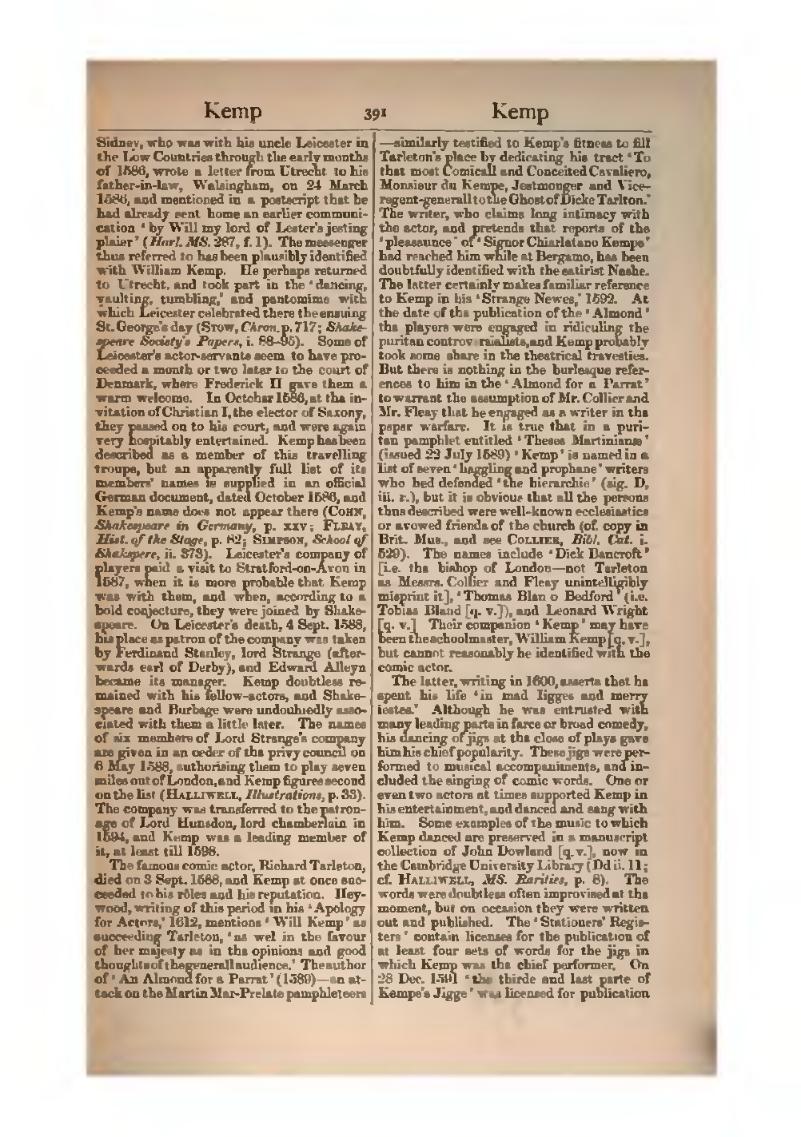Sidney, who was with his uncle Leicester in the Low Countries through the early months of 1586, wrote a letter from Utrecht to his father-in-law, Walsingham, on 24 March 1586, and mentioned in a postscript that he had already sent home an earlier communication ‘by Will my lord of Lester's jesting plaier’ (Harl. MS. 287, f. 1). The messenger thus referred to has been plausibly identified with William Kemp. He perhaps returned to Utrecht, and took part in the ‘dancing, vaulting, tumbling,’ and pantomime with which Leicester celebrated there the ensuing St. George's day (Stow, Chron. p. 717; Shakespeare Society's Papers, i. 88–95). Some of Leicester's actor-servants seem to have proceeded a month or two later to the court of Denmark, where Frederick II gave them a warm welcome. In October 1586, at the invitation of Christian I, the elector of Saxony, they passed on to his court, and were again very hospitably entertained. Kemp has been described as a member of this travelling troupe, but an apparently full list of its members' names is supplied in an official German document, dated October 1586, and Kemp's name does not appear there (Cohn, Shakespeare in Germany, p. xxv; Fleay, Hist. of the Stage, p. 82; Simpson, School of Shakspere, ii. 373). Leicester's company of players paid a visit to Stratford-on-Avon in 1587, when it is more probable that Kemp was with them. On Leicester's death, 4 Sept. 1588, his place as patron of the company was taken by Ferdinand Stanley, lord Strange (afterwards earl of Derby). Kemp doubtless remained with his fellow-actors. The names of six members of Lord Strange's company are given in an order of the privy council on 6 May 1593, authorising them to play seven miles out of London, and Kemp figures second on the list (Halliwell, Illustrations, p. 33). The company was transferred to the patronage of Lord Hunsdon, lord chamberlain in 1594, and Kemp was a leading member of it, at least till 1598. At Christmas 1594 he was summoned, with two other leading members of the company, Richard Burbage [q. v.] and William Shakespeare [q. v.], to act before the queen at Greenwich. It was probably Shakespeare's first appearance at court.
The famous comic actor, Richard Tarleton, died on 3 Sept. 1588, and Kemp at once succeeded to his rôles and his reputation. Heywood, writing of this period in his ‘Apology for Actors,’ 1612, mentions ‘Will Kemp’ as succeeding Tarleton, ‘as wel in the favour of her majesty as in the opinions and good thoughts of the generall audience.’ The author of ‘An Almond for a Parrat’ (1589)—an attack on the Martin Mar-Prelate pamphleteers—similarly testified to Kemp's fitness to fill Tarleton's place by dedicating his tract ‘To that most Comicall and Conceited Cavaliero, Monsieur du Kempe, Jestmonger and Viceregent-generall to the Ghost of Dicke Tarlton.’ The writer, who claims long intimacy with the actor, and pretends that reports of the ‘pleasaunce’ of ‘Signor Chiarlatano Kempe’ had reached him while at Bergamo, has been doubtfully identified with the satirist Nashe. The latter certainly makes familiar reference to Kemp in his ‘Strange Newes,’ 1592. At the date of the publication of the ‘Almond’ the players were engaged in ridiculing the puritan controversialists, and Kemp probably took some share in the theatrical travesties. But there is nothing in the burlesque references to him in the ‘Almond for a Parrat’ to warrant the assumption of Mr. Collier and Mr. Fleay that he engaged as a writer in the paper warfare. It is true that in a puritan pamphlet entitled ‘Theses Martinianæ’ (issued 22 July 1589) ‘Kemp’ is named in a list of seven ‘haggling and prophane’ writers who had defended ‘the hierarchie’ (sig. D. iii. v.), but it is obvious that all the persons thus described were well-known ecclesiastics or avowed friends of the church (cf. copy in Brit. Mus., and see Collier, Bibl. Cat. i. 529). The names include ‘Dick Bancroft’ [i.e. the bishop of London—not Tarleton as Messrs. Collier and Fleay unintelligibly misprint it], ‘Thomas Blan of Bedford’ (i.e. Tobias Bland [q. v.]), and Leonard Wright [q. v.] Their companion ‘Kemp’ may have been the schoolmaster, William Kemp [q. v.], but cannot reasonably be identified with the comic actor.
The latter, writing in 1600, asserts that he spent his life ‘in mad Iigges and merry iestes.’ Although he was entrusted with many leading parts in farce or broad comedy, his dancing of jigs at the close of plays gave him his chief popularity. These jigs were performed to musical accompaniments, and included the singing of comic words. One or even two actors at times supported Kemp in his entertainment, and danced and sang with him. Some examples of the music to which Kemp danced are preserved in a manuscript collection of John Dowland [q. v.], now in the Cambridge University Library (Dd ii. 11; cf. Halliwell, MS. Rarities, p. 8). The words were doubtless often improvised at the moment, but on occasion they were written out and published. The ‘Stationers' Registers’ contain licenses for the publication of at least four sets of words for the jigs in which Kemp was the chief performer. On 28 Dec. 1591 ‘the thirde and last parte of Kempe's Jigge’ was licensed for publication
